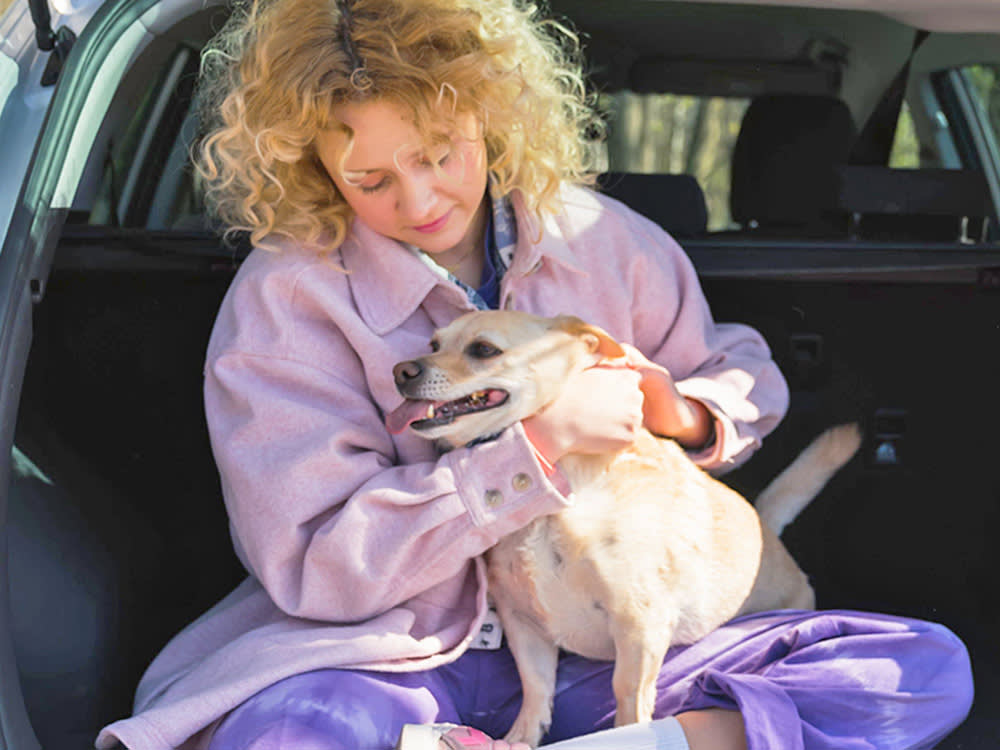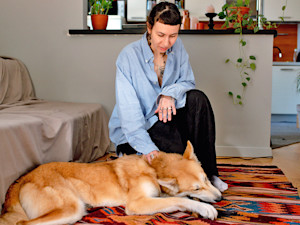What to Do If Your Dog Has Hives
They look so miserable...

Share Article
In This Article:
What To Do If My Dog Has Hives? Causes of Canine Hives How Do I Know If My Dog’s Hives Are Severe? Canine Hive Treatments
Every spring, there’s a dog parent saying: I let my dog into the yard to play. I just called her back inside, and now my dog has bumps under her fur and she’s super itchy. I think my dog has hives. Do dogs even get hives?
The appearance of hives or wheals, also called urticaria, is a form of allergic reaction in dogs. Find out what can cause canine hives and what to do if your dog has hives.
What to do if my dog has hives?
If your dog has hives all over their body (or even in just a few places), you should consider the cause, assess the severity, and take action to provide relief. So, what do dog hives look like? Dog hives look like red, circular, slightly raised areas on the skin. These raised areas of skin tend to be itchy, but should not be painful. A dog may also have facial swelling in addition.

Hives are easiest to spot on dogs with short fur and on areas of the body with less hair, like the belly. If your long-haired dog is suddenly excessively itchy, it’s a good idea to part the fur to see if your dog has hives on their back or have them lie down so you can check their belly (with belly rubs as a reward, of course).
Causes of canine hives
The sudden appearance of hives on a dog can be alarming, often leaving dog parents wondering, “Is my dog having an allergic reaction?” The answer is yes — but to what? Considering the potential cause of your dog’s hives can help you take steps to prevent exposure to triggers in the future. Possible causes of hives in dogs include:
Insect bites or stings
Vaccine reactions
Medications
Plants
Food allergies
Exposure to heat, cold, or stress (less common)
We don’t always figure out the exact cause of a dog’s hives. When I treat dogs for allergic reactions involving hives, I consider their recent activity. If they've been outdoors and were not given vaccines or new medications that day, I usually assume it’s probably an insect bite or sting, unless proven otherwise.
How do I know if my dog’s hives are severe?
Allergic reactions in dogs can range in severity from mild itchiness to life-threatening anaphylaxis. An anaphylactic reaction affects the whole body, causing dramatic changes to the circulatory, respiratory, and gastrointestinal systems. Dogs having an anaphylactic reaction will often experience a sudden drop in blood pressure, weakness, vomiting and diarrhea. Some will also collapse or have breathing difficulties.
Signs that your dog may be having a more severe allergic reaction include:
Vomiting
Diarrhea
Severe facial swelling
Lethargy
Weakness
Coughing
Collapse
Canine hive treatments
Treatment for dog hives varies depending on the severity. Dogs experiencing an anaphylactic reaction need stabilization and aggressive supportive care, which can include IV fluid therapy, oxygen, and injectable medications. Fortunately, most cases don’t require this level of intervention and can be treated on an outpatient basis.
Typical treatment for dog hives include an antihistamine and steroids. These are available as both oral medications and injections, but many vets will opt to give injections to try to get the allergic reaction under control more quickly. With prompt treatment, a dog’s hives can resolve almost as fast as they popped up.
Your vet may prescribe oral antihistamines or steroids to give at home. Depending on your dog’s medical history and the severity of allergic reaction, oral medication (like Benadryl) may be administered as the first line of treatment, but you should always contact a vet for guidance.
In addition to any medications your vet recommends, you can also apply a cold compress to your dog’s hives to help relieve the itchiness. In rare cases, this may make things worse, so keep an eye on your pup’s skin to make sure it’s helping.
When to seek expert help
A dog’s hives should always be treated by a vet; don’t wait and see if they’ll go away. Even if the hives seem mild, treatment can provide itch relief before your dog causes more harm to their skin with constant scratching.
If you’re not sure if your dog’s allergic reaction is severe, call your veterinarian or an animal emergency hospital for guidance. If there are signs of a more severe reaction — for example, if your dog has hives and is vomiting — then you should take your dog to a vet for treatment.
If you have any concern that your dog may be having an anaphylactic reaction, take your dog to a vet ASAP.
How to prevent dog hives
Many times we don’t know what triggered a dog’s hives, so it’s difficult to create a plan for prevention. However, when the trigger is known, steps can be taken to reduce risk of future allergic reactions.
Check outside your home for bees’ or wasps’ nests. Some dogs find out about spicy flies — aka those bugs that bite or sting — the hard way, and some never learn to not try to catch them. If you find nests near your home, consider professional removal for your and your dog’s safety. Remove any plants that may be irritating or toxic to pets and always keep your dog on a leash when in an unfamiliar area.
Monitor your dog closely after vaccine appointments and tell your veterinarian if your dog ever has a vaccine reaction. Your vet can take steps to reduce risk of reaction to future vaccines. This may include:
Pre-medicating your dog with antihistamines and/or steroids before vaccination
Post-vaccination monitoring in the hospital
Reducing the number of vaccines given in a single visit
If your dog has repeated episodes of hives with no known trigger, talk to your vet about allergy testing or food trials. Allergy treatments or a diet change may help with environmental or food allergies.
Bottom line
Hives, also called wheals, are a sign of an allergic reaction in dogs and require treatment. Treatment for dog hives depends on their severity, but often involves antihistamines and steroids.
Seek veterinary guidance if your dog develops hives. Pursue immediate treatment if your dog has signs of a more severe reaction such as vomiting, weakness, or breathing changes.
References
Heinrich, Nicole A. “Urticaria (Hives, Wheals) in Animals.” MSD Veterinary Manual, 2 Feb. 2024, www.msdvetmanual.com/integumentary-system/urticaria/urticaria-hives-wheals-in-animalsopens in new tab.
“Postvaccination Adverse Events and Reactions.” AAHA, 29 Oct. 2024, www.aaha.org/resources/2022-aaha-canine-vaccination-guidelines/postvaccination-adverse-events-and-reactions/opens in new tab.

Dr. Alycia Washington, DVM, MS
Alycia Washington is a small-animal emergency veterinarian with over 10 years of experience based in North Carolina. She works as a relief veterinarianopens in new tab and provides services to numerous emergency and specialty hospitals. She also works as a veterinary writer with a focus on educating pet parents.
Related articles
![Cute weimaraner dog lying on lawn and scratching its back]()
Best Allergy Medicines That You Can Give to Your Dog
Here’s what works (and what doesn’t).
Allergies in Dogs: Can Dogs Be Allergic to Cats?
Don’t blame the cat...
![A dog scratching itself among the leaves outside.]()
Immunotherapy Can Be the Solve For Your Dog’s Allergies
If allergens were to ask, “Am I the drama?,” the answer would be yes.
![Woman making dinner for her dog at home.]()
Best Food for Dogs With Allergies
Because no one deserves to be uncomfy.
![Brown terrier dog scratching its ear outdoors]()
Relief for Your Dog: Discover Effective Solutions for Their Seasonal Allergies
A vet explains why environmental allergies flare up and what to do about it.
Can Dogs Get Pimples? Causes, Symptoms, and Treatments
Time to go to the doggie dermatologist!







